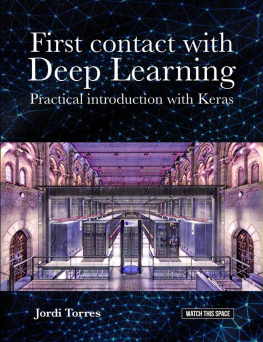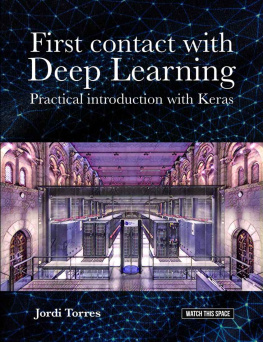First contact with
Deep Learning
Practical introduction with Keras
Jordi Torres

WATCH THIS SPACE COLLECTION - BARCELONA
2018
First contact with Deep Learning, Practical introduction with Keras
Jordi Torres
WATCH THIS SPACE collection Barcelona: Book 5
Kindle Direct Publishing.
www.amazon.com
Cover: Background (Roser Bellido). Picture (BSC-CNS using DL style transfer form algorithmia.com)
ISBN 978-1-983-21155-3
Fisrt edition: July 2018.
 Jordi Torres
Jordi Torres
http://www.JordiTorres.Barcelona
Universitat Politcnica de Catalunya - UPC Barcelona Tech
Campus Nord, mdul C6
Jordi Girona 1-3
08034 Barcelona
Writers Coach: Ferran Juli Mass
This book is licensed under a Creative Commons Attribution-NonCommercial-ShareAlike 3.0 Unported License (CC BY-NC-SA 3.0). In short: Jordi Torres retains the Copyright but you are free to reproduce, reblog, remix and modify the content only under the same license to this one. You may not use this work for commercial purposes but permission to use this material in nonprofit teaching is still granted, provided the authorship and licensing information here is displayed
To all my students at UPC (*)
(*)
According to Professor Howard Gardner, the older you are, the harder it is to adapt your life to a new idea and the easier it is to adapt that new idea to your comfortable life without changing it. That's why I go to class to unlearn from myself and learn from my young students that I have in class.
Contents:
Foreword
In 1953, Isaac Asimov published Second Foundation , the third book of the Foundation series (or the thirteenth according to other sources, this is a subject of debate). In Second Foundation Arkady Darell, one of the main characters of the final part of the saga, appears for the first time. In his first scene, Arkady, who is 14 years old, is doing his homework. Specifically, an essay entitled "Seldon Plan". To do the writing, Arkady is using a "transcription machine", a device that converts his voice into written words. Arkady speaks into the machine and it prints out his words in a fancy calligraphic font. This type of device, which for Isaac Asimov was science fiction in 1953, is available in most of our smartphones, and Deep Learning is one of the factors responsible for it, in addition to advances in technology.
On the other hand, the computing technology currently available is another of the key factors responsible for us having these applications. Nowadays we have GPUs (Graphics Processor Units), which only cost around 100 euros, which would be on the Top500 list a few years ago (competing with machines that cost millions of euros). The GPUs were designed to facilitate the programming of video games, but a combination of small changes (unified shaders, shared memory, memory access instructions, Tensor Cores ... it may not be so small!), and the emergence of new programming models (CUDA, OpenCL, OpenACC), have facilitated the efficient use of GPUs in general-purpose applications, including Deep Learning. In addition, considering that every year more than 1,000 million smartphones are sold (all of them have a GPU) and that the videogame business is very attractive, it is guaranteed that the technological improvement of GPUs will continue for a long time.
I have known Jordi for more than 30 years; He has always been very concerned about the latest technological advances, not only in our area of knowledge, Computer Architecture , but also in broader issues that we could include in what is known as Computer Science . Jordi is thinking about research, but also about transferring that knowledge to our students (this, and no other, is the ultimate goal of research at the university). Considering this, it is not surprising that he has embarked on publishing a series of books dedicated to Deep Learning. These tools are changing the way computer problems are addressed and are opening the spectrum of what a computer can do.
And what will the future hold? To be better informed, we can start reading this book, but in the next few years, we will have a series of revolutionary applications closely related to Deep Learning: autonomous cars, natural language processing, machine translation...
Those who will have many more difficulties will be the writers of science fiction: It will be very difficult for them to imagine new devices that have not already been designed by current engineers.
Agustn Fernndez
Vice-rector for Digital Transformation
Universitat Politcnica de Catalunya BarcelonaTech
Pref ace: the passion to teach
Education is the most powerful weapon which you can use to change the world.
Nelson Mandela
Those who know me, know that something that has always motivated me, is to contribute by being the proverbial spark that lights the fire and awakens minds, in order to be prepared for the changes that our society faces, in the wake of the impact of technologies such as artificial intelligence in general and Deep Learning in particular.
I've always been interested in next-generation technology and its impact, and that's why artificial intelligence and its relationship with technologies such as Cloud Computing, Big Data or supercomputing (high performance computing) have caught my interest. These are areas in which I have been researching and teaching for 30 years.
Undoubtedly, technological advances in Artificial Intelligence, along with the other aforementioned technologies, are already here and allow us to build a society that improves people's lives. On the other hand, it is also true that in the near future these technologies will present other uncertainties.
I am however convinced , that together, as a society, we can find solutions to new problems we come across, that are brought about by these new technologies. For this reason, it is key that each and every one of us who working in the world of technology has a better understanding of these new topics that are revolutionizing IT, in order that we can use them correctly and also be able to explain them to society.
This book is an English translation of the recently published book Deep Learning - Introduccin prctica con Keras that I wrote during the free time that my academic and research activity allowed me.
The book was initially designed to support my classes at the Facultat dInformtica de Barcelona , the faculty of Computer Science of the Universitat Politcnica de Catalunya Barcelona Tech (UPC).
And as I have done with all the books in the collection WATCH THIS SPACE, I have openly published all its content on my personal website https://www.JordiTorres.org /DeepLearning
I'm excited to share it with all my students and with the entire IT community interested in having a first contact with this technology and help them to start on their own in the programming of Deep Learning. I hope this introductory book will help the reader interested in starting their adventure in this very interesting field. If the reader finds the content useful and prefers to opt for a paper copy or eBook copy, it can be purchased on Amazon .
As the title suggests, this book is only intended to be a practical introduction to Deep Learning, currently one of the most active areas in the field of Artificial Intelligence. It is not meant as an exhaustive treatise on the subject. This book is aimed at the reader who has knowledge in programming but has not yet had the opportunity to start these new key concepts in computing, and wants to discover some of the possibilities and more cutting-edge aspects of this technology.














 Jordi Torres
Jordi Torres